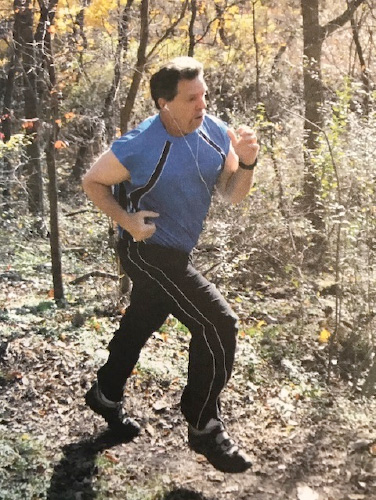
Tortoise and Hare Cardio Training
Mixing methods keeps training fresh, exciting and challenging
For the past twenty years I have done my cardio training outside. Weather permitting, I trot, jog or sprint on a stunningly picturesque 170-acre mountainside farm in rural Pennsylvania. I have, over the years, created dozens of separate and distinct cardio "circuits," specific routes of varying lengths that take a specified amount of time to complete. My various cardio routes create a spider web matrix that crisscrosses the farm.
Six weeks ago, I set about to create a route that would take 45-minutes to complete, this with me hauling ass for every single minute. I played with different route combinations until I hit on one that fit the bill perfectly. On a good day, going all out, pushing to the outer limits of my 100% capacity, my "jump in" time for the new route was 44 minutes and 45 seconds. This was a good time done on a good day giving my all. This would serve as my aerobic benchmark against which to compare all future efforts.
I really liked this topographical configuration. My new route was chock full of geographical contrast: enclosed wooded sections, sprint sections, grind-speed sections, super steep 45-degree mountain trails, long gradual uphill grades, steep downhills, all this variety experienced in a single 45-minute session.
In the warm summer months, I run at dawn. I start my cardio session by putting on my earphones and using YouTube to call up something fittingly surreal. Most recently I have been listening to Miles Davis during his 1970 On the Corner and Jack Johnson phase. I start the music, toggle to the stopwatch function on my iPhone and start the timer. I commence my 45-minute route running on a woodchip pathway under a tree canopy so dense that on light and medium rain days, I remain dry while running under this thick, lush, ancient growth tree canopy.
As I mentioned, my initial "jump in" time for this highly specific farm route was 44 minutes and 45 seconds. As is my habit, I set up a competition with myself. At the start of each dawn session I make a conscious choice between two highly specific and entirely different approaches: I select either "sprint mode" or "steady-state" mode.
I established a personal best of 44:45 using steady-state mode. In my first sprint mode session, I ran 43:37. I create "PRs" (personal records) in both styles and continually seek to improve upon these marks. I established some hard and fast rules: when I used the steady-state style I could do no sprinting. When I used the sprint-and-recover mode it was for the whole circuit. No fuzzing of the two styles, one or the other.
I called this approach "tortoise" (steady-state) or "hare" (sprint) cardio. Interestingly and surprisingly, best times in each mode were roughly identical. My jump in for steady state was 44:45 and 43:37 for sprint/recover/sprint again. I had thought that sprint-and-recover would generate much faster times than my steady-state. I really liked the sprint template and by comparison, steady-state seemed sluggish (relatively.) I am far better at sprinting than doing steady-state so I was a bit shocked that initially the two best times were within 35 seconds of one another.
Originally, I had wanted to use sprint/recover/sprint again mode exclusively. Sprint my ass off every single day. That proved impossible. Sprinting, like heavy squatting, decimates the legs – if done right. Sprinting all out takes the athlete up to and past capacity, repeatedly, in the same session. Sprint legs, like squat legs, need to recover and become fresh before training them again. The leg stress that accompanies repeated 100-105% sprint efforts stress legs, hip, lower back and ab muscles. I push right to the productive edge of the injury abyss.
A natural ebb-and-flow developed between the two styles: if my legs felt fresh I would use my favored sprint/recover/sprint again mode. If my legs were dead, it was steady-state time. I noted that after a good sprint session my legs were totally dead for sprinting the next day; however dead for sprinting was not dead for steady-state. While my legs were fried insofar as generating 100% short burst efforts, I was consistently able to turn in personal record steady-state times the day after an all-out sprint day.
My steady-state goal was, over time, to systematically ratchet up the pace (incrementally, infinitesimally) thereby generating faster finish times. The sprint/recover/sprint again goal was to become a faster sprinter, thereby generating a faster finish time.
I have been using this cardio approach for six weeks now, and have significantly whittled down my personal bests in both modes. My new goal is to "break the 40-minute barrier, this would slash a full four minutes of my jump-in time of 44:45. Motivation is critical and this goal seemed doable assuming I got serious and put in the sessions.
I was elated when after four weeks I used sprint/recover mode to hit 39:43. A few days later I posted an astonishing (to me) 38.40 steady-state time. The cherry on the sundae was when last week, after being off for two days and having fresh legs, I used sprint mode to hit a 36:29 time.
I figured out why my two modes had roughly equal times: I was taking too much time in between sprints. Whatever yardage I gained being the hare I was giving back by taking lollygagging between sprints. I needed to mindfully keep my pace up between sprints – which proved to be tough after an all-out 100% effort.
I found the deeper I got into sprinting, my "effortless" all out-sprint length increased from 30 yards to 50 yards. This ability to sprint further ate up ground and helped tremendously in lowering my times. I could eat up a lot more real estate using 50-yard bursts as opposed to 30 yards. I just needed to keep moving at a decent pace between sprints.
Naturally, my new goal is to break "the 35-minute barrier." Not coincidentally I have shed 10 pounds of bodyweight in six weeks by syncing this near-daily cardio with a ketogenic dietary approach. Be creative in your own cardio efforts, create internal cardio challenges, regardless the mode or method. Use your imagination and be inventive with your training. The trick is to inject variety into training without diluting the effectiveness.
About the Author
As an athlete Marty Gallagher is a national and world champion in Olympic lifting and powerlifting. He was a world champion team coach in 1991 and coached Black's Gym to five national team titles. He's also coached some of the strongest men on the planet including Kirk Karwoski when he completed his world record 1,003 lb. squat. Today he teaches the US Secret Service and Tier 1 Spec Ops on how to maximize their strength in minimal time. As a writer since 1978 he’s written for Powerlifting USA, Milo, Flex Magazine, Muscle & Fitness, Prime Fitness, Washington Post, Dragon Door and now IRON COMPANY. He’s also the author of numerous books including Purposeful Primitive, Strong Medicine, Ed Coan’s book “Coan, The Man, the Myth, the Method" and numerous others. Read the Marty Gallagher biography here.



